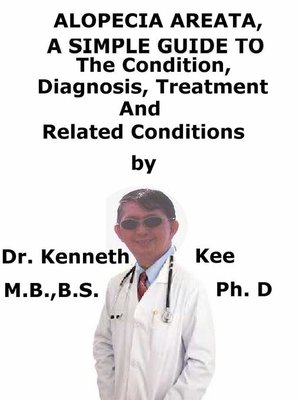Alopecia Areata, a Simple Guide to the Condition, Diagnosis, Treatment and Related Conditions
ebook
By Kenneth Kee

Sign up to save your library
With an OverDrive account, you can save your favorite libraries for at-a-glance information about availability. Find out more about OverDrive accounts.
Find this title in Libby, the library reading app by OverDrive.



Search for a digital library with this title
Title found at these libraries:
| Library Name | Distance |
|---|---|
| Loading... |
Alopecia areata is a medical disorder that produces round patches of baldness.It can result in total hair loss( alopecia totalis).In some patients, total baldness develops.In many patients, the hair re-grows, normally after several months.In some patients, the hair loss is permanent.Alopecia means loss of hair or baldness.Alopecia areata is one form of hair loss.Alopecia areata can happen at any age but most patients first get it as teenagers and children.At least 50% of the people with alopecia areata form their first patch of hair loss before they are 21.Males and females are identically affected.The disorder tends to be milder when it first forms at an older age.CausesAlopecia areata is believed to be an autoimmune disorder.This happens when the immune system falsely attacks and destroys healthy body tissue.In people with alopecia areata, many white blood cells get together around the affected hair roots (hair follicles) which are mistaken as foreign.This causes some mild inflammation.The inflammation results in hairs becoming weak and falling out to produce the bald patches.It is not known why it is frequent for only certain areas of the scalp to be affected.Also, the involved hair follicles are not damaged.The involved hair follicles are capable of producing normal hair again if the immune reaction goes away and the disorder returns to normal.It is not known why alopecia areata or other autoimmune diseases happen.It is believed that something stimulates the immune system to react against one or more of the body's own tissues.Possible stimuli are viruses, infection, medicines or other environmental factors.There is also a genetic factor which makes some people more vulnerable to autoimmune diseases.Hair loss is normally the only symptom.The normal pattern is for one or more bald patches to occur on the scalp.These tend to be round in shape and can be about the size of a large coin.They form quite rapidly.A relative, friend or hairdresser may be the first person to observe the bald patch or patches.Besides the bald patch or patches, the scalp normally looks healthy and there is no scarring.Sometimes, there is some mild redness, mild scaling, mild burning or a slightly itchy feeling on the bald patches.DiagnosisThe doctor will examine the patient and ask about the symptoms, focusing on areas where the patient has hair loss.A scalp biopsy may be performed.Blood tests may also be done to check for autoimmune disorders and thyroid problems.TreatmentIf hair loss is not serious, the hair will often re-grow in a few months without treatment.For more serious hair loss, it is not known how treatment can help alter the course of the disorder.Frequent treatments may be:1. Steroid injection under the skin surface2. Medicines applied to the skin3. Ultraviolet light therapy4. The wig may be used to hide areas of hair loss.Watchful waiting or not treating is a frequent initial method.Alopecia areata is normally a very non-predictable disorder.In many patients, bald patches may re-grow by themselves without treatment.Any re-growth normally does not start within three months of hair loss.An alteration in hairstyle may perhaps hide one or two small bald patches.If the hair loss becomes more extensive then the decision on whether to treat may be re-assessed.But even with extensive hair loss, there is still a possibility that hair will re-grow without treatment.Alopecia areata itself will not injure the general health and so not treating will not result in any general health disorders.Steroid injections (about 1 cm apart) are believed to be the most effective treatment for patches of alopecia areata that are not too bigTABLE OF CONTENTIntroductionChapter 1 Alopecia AreataChapter 2...







